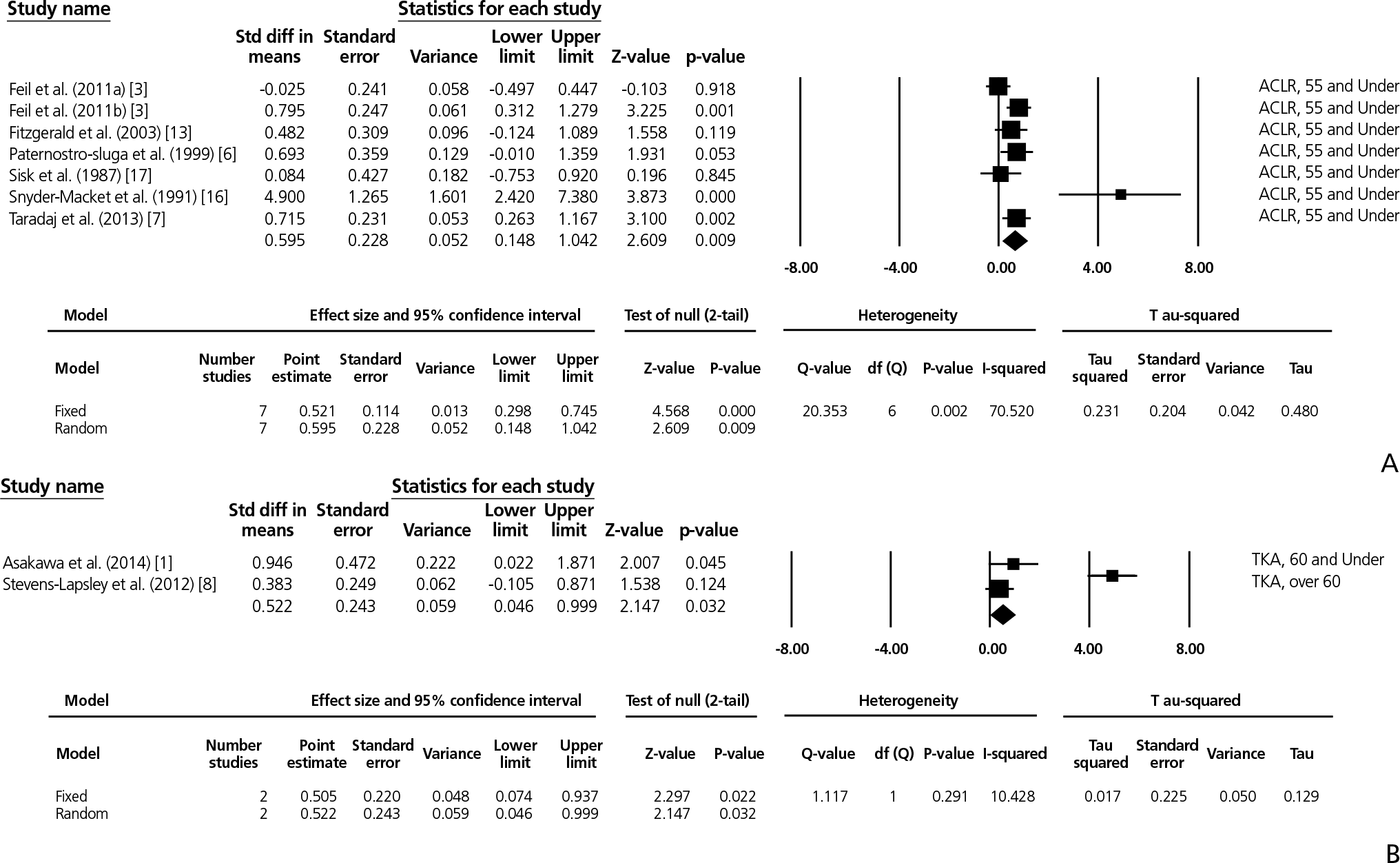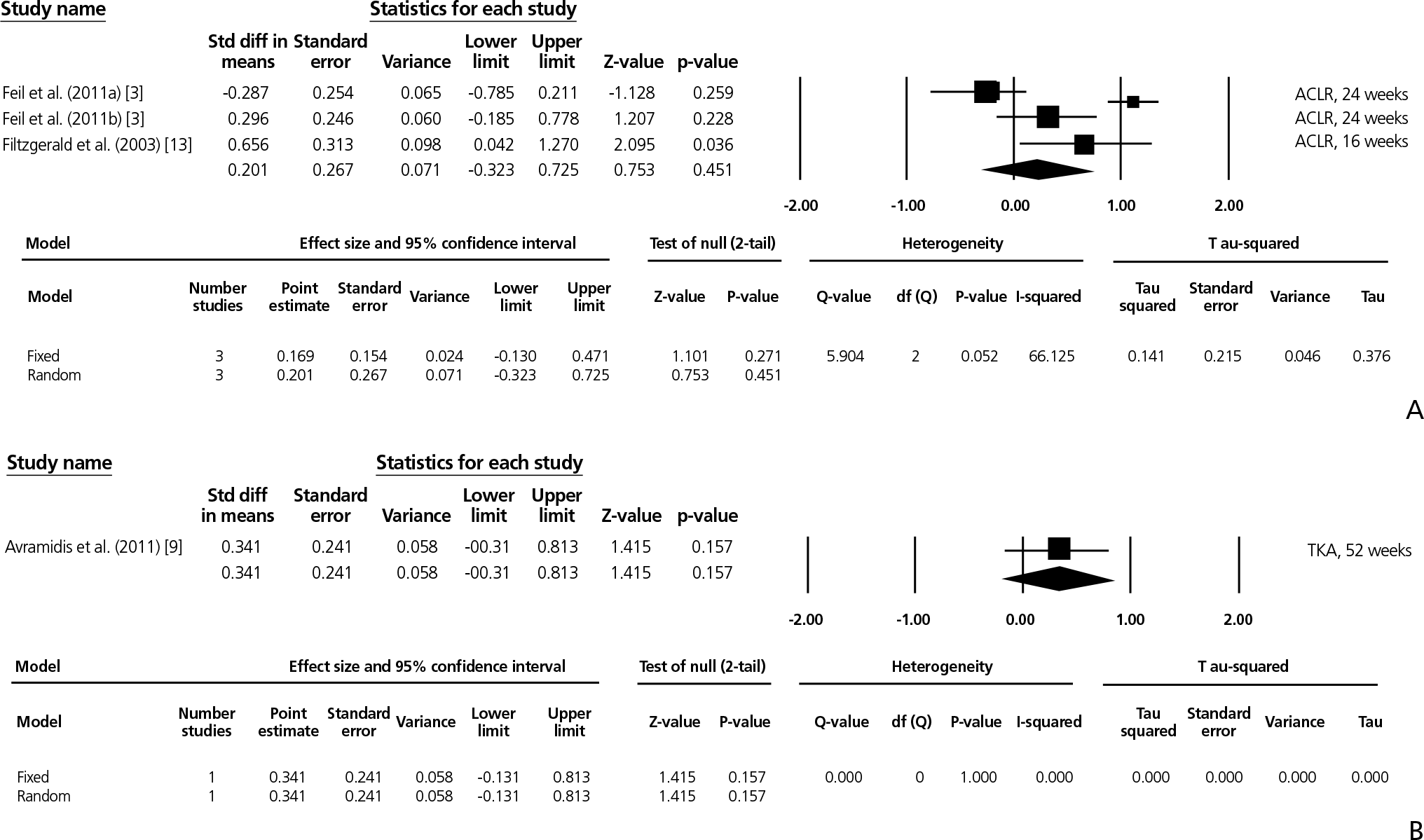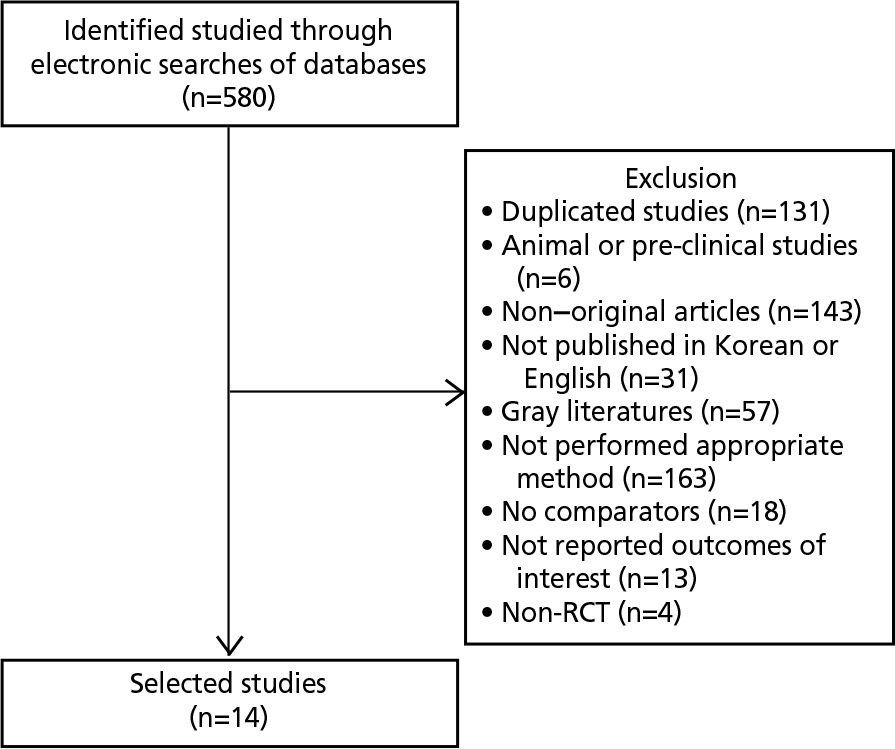Abstract
The recovery of quadriceps muscle strength and knee function after knee surgery is important. Recently, neuromuscular electrical stimulation (NMES), which is a method in which an electrical current is applied to the surrounding targeted muscle, has been incorporated into muscle-strengthening programs. The objective of this review was to evaluate the safety and effectiveness of NMES in patients who have undergone knee surgery. A database search was performed in 8 Korean databases, Medline, Embase, and the Cochrane Library. Article selection and quality assessment were performed by 2 reviewers. Of the 580 articles selected, 14 papers (randomized controlled trials) were included in the final assessment. In the results of the metaanalysis, NMES combined with rehabilitation demonstrated a significant improvement in the enhancement of quadriceps muscle strength after anterior cruciate ligament reconstruction. On the basis of the currently available data, NMES with rehabilitation is associated with favorable outcomes, and should be considered a safe and effective procedure for enhancing quadriceps muscle strength.
Go to : 
REFERENCES
1. Asakawa Y, Jung JH, Koh SE. Neuromuscular electrical stimulation improves strength, pain and weight distribution on patients with knee instability post surgery. Phys Ther Rehabil Sci. 2014; 3:112–118.

2. Frost H, Lamb SE, Robertson S. A randomized controlled trial of exercise to improve mobility and function after elective knee arthroplasty: feasibility, results and methodological difficulties. Clin Rehabil. 2002; 16:200–209.

3. Feil S, Newell J, Minogue C, Paessler HH. The effectiveness of supplementing a standard rehabilitation program with superimposed neuromuscular electrical stimulation after anterior cruciate ligament reconstruction: a prospective, randomized, single-blind study. Am J Sports Med. 2011; 39:1238–1247.
4. Han TR, Bang MS, Jeong SG. Rehabilitation medicine. 5th ed.Seoul: Koonja Publishing;2008.
5. Stevens JE, Mizner RL, Snyder-Mackler L. Neuromuscular electrical stimulation for quadriceps muscle strengthening after bilateral total knee arthroplasty: a case series. J Orthop Sports Phys Ther. 2004; 34:21–29.

6. Paternostro-Sluga T, Fialka C, Alacamliogliu Y, Saradeth T, Fialka-Moser V. Neuromuscular electrical stimulation after anterior cruciate ligament surgery. Clin Orthop Relat Res. 1999; 368:166–175.

7. Taradaj J, Halski T, Kucharzewski M, Walewicz K, Smykla A, Ozon M, Slupska L, Dymarek R, Ptaszkowski K, Rajfur J, Pasternok M. The effect of neuromuscular electrical stimulation on quadriceps strength and knee function in professional soccer players: return to sport after ACL reconstruction. Biomed Res Int. 2013; 2013:802534.

8. Stevens-Lapsley JE, Balter JE, Wolfe P, Eckhoff DG, Kohrt WM. Early neuromuscular electrical stimulation to improve quadriceps muscle strength after total knee arthroplasty: a randomized controlled trial. Phys Ther. 2012; 92:210–226.

9. Avramidis K, Karachalios T, Popotonasios K, Sacorafas D, Papathanasiades AA, Malizos KN. Does electric stimulation of the vastus medialis muscle influence rehabilitation after total knee replacement? Orthopedics. 2011; 34:175.

10. Boucher T, Wang S, Trudelle-Jackson E, Olson S. Effectiveness of surface electromyographic biofeedback-triggered neuromuscular electrical stimulation on knee rehabilitation. N Am J Sports Phys Ther. 2009; 4:100–109.
11. Petterson SC, Mizner RL, Stevens JE, Raisis L, Bodenstab A, Newcomb W, Snyder-Mackler L. Improved function from progressive strengthening interventions after total knee arthroplasty: a randomized clinical trial with an imbedded prospective cohort. Arthritis Rheum. 2009; 61:174–183.

12. Avramidis K, Strike PW, Taylor PN, Swain ID. Effectiveness of electric stimulation of the vastus medialis muscle in the rehabilitation of patients after total knee arthroplasty. Arch Phys Med Rehabil. 2003; 84:1850–1853.
13. Fitzgerald GK, Piva SR, Irrgang JJ. A modified neuromuscular electrical stimulation protocol for quadriceps strength training following anterior cruciate ligament reconstruction. J Orthop Sports Phys Ther. 2003; 33:492–501.

14. Ross M. The effect of neuromuscular electrical stimulation during closed kinetic chain exercise on lower extremity performance following anterior cruciate ligament reconstruction. Res Sports Med. 2000; 9:239–251.

15. Snyder-Mackler L, Delitto A, Bailey SL, Stralka SW. Strength of the quadriceps femoris muscle and functional recovery after reconstruction of the anterior cruciate ligament: a prospective, randomized clinical trial of electrical stimulation. J Bone Joint Surg Am. 1995; 77:1166–1173.

16. Snyder-Mackler L, Ladin Z, Schepsis AA, Young JC. Electrical stimulation of the thigh muscles after reconstruction of the anterior cruciate ligament: effects of electrically elicited contraction of the quadriceps femoris and hamstring muscles on gait and on strength of the thigh muscles. J Bone Joint Surg Am. 1991; 73:1025–1036.

Go to : 
 | Figure 2.Results of metaanalysis for quadriceps indices. (A) Anterior cruciate ligament reconstruction (ACLR) and (B) Total knee arthroplasty (TKA). |
 | Figure 3.Results of metaanalysis for knee function indices. (A) Anterior cruciate ligament reconstruction (ACLR) and (B) Total knee arthroplasty (TKA). |
Table 1.
SIGN criteria for assignment of levels of evidence
Table 2.
SIGN criteria for assignment of grades of recommendation
Table 3.
Study characteristics of included studies
Table 4.
Summary of results - quadriceps muscle strength




 PDF
PDF ePub
ePub Citation
Citation Print
Print



 XML Download
XML Download